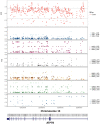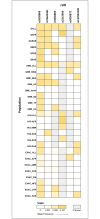DALIA- a comprehensive resource of Disease Alleles in Arab population
- PMID: 33439861
- PMCID: PMC7806169
- DOI: 10.1371/journal.pone.0244567
DALIA- a comprehensive resource of Disease Alleles in Arab population
Abstract
The Arab population encompasses over 420 million people characterized by genetic admixture and a consequent rich genetic diversity. A number of genetic diseases have been reported for the first time from the population. Additionally a high prevalence of some genetic diseases including autosomal recessive disorders such as hemoglobinopathies and familial mediterranean fever have been found in the population and across the region. There is a paucity of databases cataloguing genetic variants of clinical relevance from the population. The availability of such a catalog could have implications in precise diagnosis, genetic epidemiology and prevention of disease. To fill in the gap, we have compiled DALIA, a comprehensive compendium of genetic variants reported in literature and implicated in genetic diseases reported from the Arab population. The database aims to act as an effective resource for population-scale and sub-population specific variant analyses, enabling a ready reference aiding clinical interpretation of genetic variants, genetic epidemiology, as well as facilitating rapid screening and a quick reference for evaluating evidence on genetic diseases.
Conflict of interest statement
The authors have declared that no competing interests exist.
Figures





References
-
- Arab Countries 2020 n.d. https://worldpopulationreview.com/country-rankings/arab-countries (accessed November 21, 2020).
-
- Member states of the Arab League n.d. https://www.worlddata.info/alliances/arab-league.php (accessed November 21, 2020).
-
- Al-Gazali L, Hamamy H, Al-Arrayad S. Genetic disorders in the Arab world. BMJ 2006;333:831–4. 10.1136/bmj.38982.704931.AE - DOI - PMC - PubMed
Publication types
MeSH terms
LinkOut - more resources
Full Text Sources
Other Literature Sources
Miscellaneous

